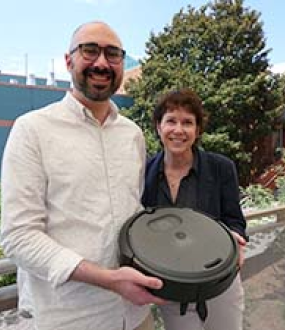The project aimed to improve students' computational thinking skills, self-efficacy, and attitude toward computing via tangible projects that simulate real-world scenarios.
The project included a series of 5 robotics challenges the students were expected to complete over the course of two phases. In these challenges, students wrote code to implement various robot behaviors, such as making autonomous deliveries and maze navigation.
To assess the project's impact, we used CIOS responses, student reflections, and exam grades throughout the semester. We compared the intervention section with robotics projects to a control section where students worked on web development labs.
CIOS Analyses: the students in the intervention section consistently (70%) mentioned the robots as their favorite part of the class. In their statements they usually mentioned appreciating the opportunity to see a real-world direct application of the coding skills they developed as part of the course.
Student reflections: the students who chose to complete the extra-credit portion of the labs created LinkedIn posts about their experiences working with the robots. They consistently mentioned feeling confident in their skills and ability to implement software that produces tangible outcomes. Many of them also mentioned that this was their favorite course, suggesting an improved attitude towards computing especially if they were non-majors in CS.
Grades analyses: to evaluate the project's impact on students' computational skills, the grades of midterms and final exams are compared. The literature indicates the first exam usually assesses prior familiarity with the course content. Therefore, we treat it as a predictor of prior coding experience. When comparing the overall performance of the two sections, we find no significant distinction, with the intervention and control sections, respectively, having 87% and 85% of the students scoring a B or better. The impact of the intervention is better captured at a more granular scale. To identify the progression of students over the course, the final exam improvement was calculated as 2*final exam/(exam 2 + exam 3) - 1. This metric gives us the percent by which they improved their computational skills over the semester. In the control section, the average improvement of the entire class was 6%, with the inexperienced students (those who scored below the median in Exam 1) seeing an improvement of 7%. In the meantime, the overall class improvement in the intervention group was 8% with the inexperienced students having an average improvement of 14%. This suggests that the lab had a more significant impact on students who struggled with the concepts at first. This suggests that the projects may help close a gap in student achievement originating from previous experiences with coding in high school.
USG Teaching and Learning Conference, 2024


TTL means creating learning experiences that help students grow their skills and knowledge, as well as their sense of self, in equal measures. TTL helps students realize that to succeed in a profession or a field, they need to pull from all aspects of their character to build meaning and meaningful things.